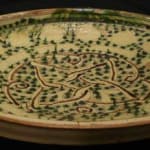Bamiyan 'Sgraffiato' Dish, 1000 CE - 1200 CE
Buff Earthenware
15.5 x 2.6
AMD.175
According to the historian ‘Ala al-Din ‘Ata- Malik Juvayni d. 1283 AD the city of Bamiyan suffered great retribution in 1221-2 AD at the hands of the Mongol Emperor Chingiz...
According to the historian ‘Ala al-Din ‘Ata- Malik Juvayni d. 1283 AD the city of Bamiyan suffered great retribution in 1221-2 AD at the hands of the Mongol Emperor Chingiz Khan, because his favorite grandson Mutugen, son of Chaghatay was killed in that city. Chingiz Khan gave orders that every living creature should be killed and no prisoners be taken; and that henceforth no living creature should inhabit the place henceforth. Such a catastrophe might be good reason for the number of preserved pieces found from that area. The incised wares of Eastern Ancient Iran (present day Afghanistan) have only emerged in fairly recent archeological publications. They represent a very widespread and diverse manufacture. Significant quantities have survived in very good condition, like the associated fritwares.
This dish resembles those first reported from the site of Bamiyan (see Gardin, 1957; especially pls 2-3). Its form and decoration derive from metalwork. It has a gently sloping cavetto and near vertical rim. This dish distinguishes itself by its similarity to the originally published examples and rests on a footring. Some similar pieces have three conical feet upon which they stand in addition to the footring, which appear to have been an afterthought on the design.
This bold earthenware dish has decoration incised (hence “Sgraffiato”) through a white slip, with lively coloring in purple and green bringing a warm ethnic energy to the piece, under a transparent glaze. The main decorative motif is a geometric rosette encircled by arabesque scrolling and further surrounded by an outer-ring of decoration of teardrop shaped leaves. For comparable examples see Oliver Watson, Ceramics from Islamic Lands, cataloging the Al-Sabah Collection in the Kuwait National Museum, 2004. cat. Ie.1. Also Earnst J. Grube, Cobalt and Lustre, The Nasser D. Khallili Collection of Islamic Art, 1994.
This dish resembles those first reported from the site of Bamiyan (see Gardin, 1957; especially pls 2-3). Its form and decoration derive from metalwork. It has a gently sloping cavetto and near vertical rim. This dish distinguishes itself by its similarity to the originally published examples and rests on a footring. Some similar pieces have three conical feet upon which they stand in addition to the footring, which appear to have been an afterthought on the design.
This bold earthenware dish has decoration incised (hence “Sgraffiato”) through a white slip, with lively coloring in purple and green bringing a warm ethnic energy to the piece, under a transparent glaze. The main decorative motif is a geometric rosette encircled by arabesque scrolling and further surrounded by an outer-ring of decoration of teardrop shaped leaves. For comparable examples see Oliver Watson, Ceramics from Islamic Lands, cataloging the Al-Sabah Collection in the Kuwait National Museum, 2004. cat. Ie.1. Also Earnst J. Grube, Cobalt and Lustre, The Nasser D. Khallili Collection of Islamic Art, 1994.



